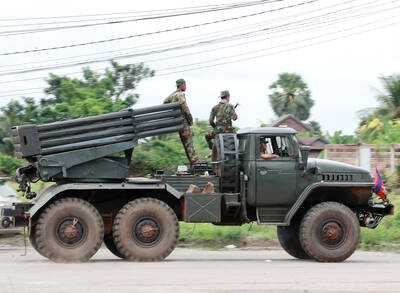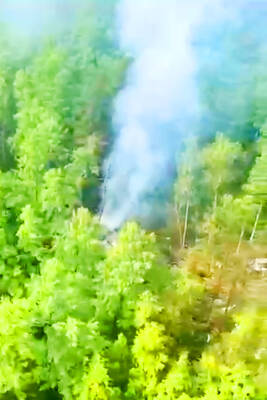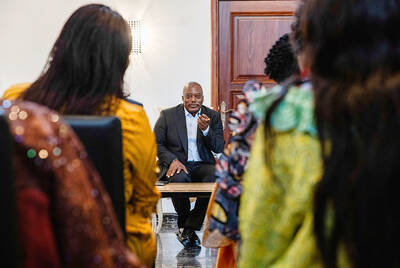What do a luxury Chinese apartment tower, a workers’ dormitory, a low-income housing block and an empty field have in common?
They all qualify as affordable housing projects under a government scheme that policymakers hope will cool popular anger over high housing prices, and that analysts are counting on to keep China’s property sector afloat.
The program, which targets 36 million units of new housing by 2015 at a cost of nearly US$800 billion, has underpinned demand for steel, cement and metals from the world’s second-largest economy as the larger real estate sector cools.
However, the huge numbers don’t add up to enough to ease concerns that the Chinese economy is paying the price for the government’s crackdown on “speculative” real estate projects.
“It’s an illusion to try to hang on to the notion that social housing will have a massive pull on raw materials in China. It does have a pull but not significant enough” to make up for freezing commercial real estate spending, said Nicholas Zhu, of ANZ Bank in Shanghai.
To gauge the status of the scheme, Reuters visited a dozen building sites in the dusty city of Shijiazhuang, south of Beijing. A middle-income city of 10 million, including satellite towns, Shijiazhuang is one of the few to have published a public list of its affordable housing projects.
Tall towers rising from flat fields and former industrial sites laid to rest the assumption of some that local governments are simply faking affordable housing starts to meet central government targets. In Shijiazhuang at least, the projects are real.
However, a good portion of what’s being built is already-planned construction re-labeled as affordable housing. Those projects aren’t delivering the additional demand for concrete, steel, glass or aluminum window frames that typically ensure that construction gives an outsized boost to economic growth.
If the affordable housing program cannot deliver additional demand, the restrictions on commercial housing may deliver a greater blow to the broader economy than Beijing intended.
For two years, China has restricted bank lending to the real estate sector and limited citizens’ ability to buy multiple homes, or homes in other cities, to curb speculation in high-end housing. The campaign has finally started to impact prices.
Reuters visited projects ranging from tall towers of apartments measuring 60m2 or less — what most Chinese would call affordable housing — to factory and school dormitories. At least two projects were part of luxury housing developments.
This seems to reflect what is happening across China.
Recent government announcements indicate that new off-market, affordable housing units will increasingly be made up of reclassified, non-commercial projects like dormitories attached to schools, hospitals, government departments and state-owned enterprises.
“There’s a big difference between government definitions and what a normal person would consider an ‘affordable house,’” GK Dragonomics research manager Rosealea Yao said.
Reclassification jibes with a shift in official targets from housing starts — which critics charge are easily faked — to completions. Beijing targets 5 million completions this year, up from the official count of 4.32 million completed last year.
Nationwide, affordable housing numbers are confusing. Chinese Premier Wen Jiabao (溫家寶) said last year that China would build 36 million units by 2015, with 10 million to start building last year alone, as citizens seethed over red-hot property prices.
Beijing then retreated in the face of limited local budgets and allegations that corrupt insiders get dibs on homes. It shelved plans for subsidized apartments to sell to low-income buyers in favor of modest apartments to rent to the poor.
The target for this year starts is now 7 million units.
Many analysts felt that the original target was so far from reality that actual starts this year might exceed last year. Official, yet widely disbelieved, statistics put affordable home starts at 10.43 million last year.
Bank of America Merrill Lynch estimates that the number of units actually under construction will rise to 7.3 million this year from 3.7 million last year.
“Social housing starts have been overstated, but still the increase in construction of off-market housing will more than offset the fall in the market segment,” a recent report by Beijing-based consultancy GK Dragonomics said.
Not so, Zhu said. His back-of-the-envelope calculations show that government targets for affordable housing would absorb only about 50 million tonnes of steel.
That’s only one-sixth of China’s construction steel output, meaning that the real estate freeze can still create a dangerous glut.
Even if reclassified projects don’t represent new demand per se, they could allow the government to declare victory and relax the controls strangling the commercial property sector.
Three sites visited by Reuters in Shijiazhuang turned out to be newly completed dormitories.
Beijing is “taking a two-pronged approach of temporarily repressing demand for commercial units and also building lower-priced housing for the population that’s been priced out of the commercial market,” CLSA strategist Andy Rothman said. “Once they make progress on both fronts they can ease the current restrictions on commercial home sales.”
Some property developers are committing to build affordable housing to get approval for more lucrative developments. That lets local governments balance their budgets with land sales. Some cities use “slum clearing” to move poorer residents out of the valuable city center and auction off the land to yet another glitzy developer. ally, land use data showed.
China needs to build 10 million units a year until 2030 to meet a 70 million unit shortfall and upgrade shoddy housing.

POLITICAL PATRIARCHS: Recent clashes between Thailand and Cambodia are driven by an escalating feud between rival political families, analysts say The dispute over Thailand and Cambodia’s contested border, which dates back more than a century to disagreements over colonial-era maps, has broken into conflict before. However, the most recent clashes, which erupted on Thursday, have been fueled by another factor: a bitter feud between two powerful political patriarchs. Cambodian Senate President and former prime minister Hun Sen, 72, and former Thai prime minister Thaksin Shinawatra, 76, were once such close friends that they reportedly called one another brothers. Hun Sen has, over the years, supported Thaksin’s family during their long-running power struggle with Thailand’s military. Thaksin and his sister Yingluck stayed

FOREST SITE: A rescue helicopter spotted the burning fuselage of the plane in a forested area, with rescue personnel saying they saw no evidence of survivors A passenger plane carrying nearly 50 people crashed yesterday in a remote spot in Russia’s far eastern region of Amur, with no immediate signs of survivors, authorities said. The aircraft, a twin-propeller Antonov-24 operated by Angara Airlines, was headed to the town of Tynda from the city of Blagoveshchensk when it disappeared from radar at about 1pm. A rescue helicopter later spotted the burning fuselage of the plane on a forested mountain slope about 16km from Tynda. Videos published by Russian investigators showed what appeared to be columns of smoke billowing from the wreckage of the plane in a dense, forested area. Rescuers in

‘ARBITRARY’ CASE: Former DR Congo president Joseph Kabila has maintained his innocence and called the country’s courts an instrument of oppression Former Democratic Republic of the Congo (DR Congo) president Joseph Kabila went on trial in absentia on Friday on charges including treason over alleged support for Rwanda-backed militants, an AFP reporter at the court said. Kabila, who has lived outside the DR Congo for two years, stands accused at a military court of plotting to overthrow the government of Congolese President Felix Tshisekedi — a charge that could yield a death sentence. He also faces charges including homicide, torture and rape linked to the anti-government force M23, the charge sheet said. Other charges include “taking part in an insurrection movement,” “crime against the

POINTING FINGERS: The two countries have accused each other of firing first, with Bangkok accusing Phnom Penh of targeting civilian infrastructure, including a hospital Thai acting Prime Minister Phumtham Wechayachai yesterday warned that cross-border clashes with Cambodia that have uprooted more than 130,000 people “could develop into war,” as the countries traded deadly strikes for a second day. A long-running border dispute erupted into intense fighting with jets, artillery, tanks and ground troops on Thursday, and the UN Security Council was set to hold an emergency meeting on the crisis yesterday. A steady thump of artillery strikes could be heard from the Cambodian side of the border, where the province of Oddar Meanchey reported that one civilian — a 70-year-old man — had been killed and